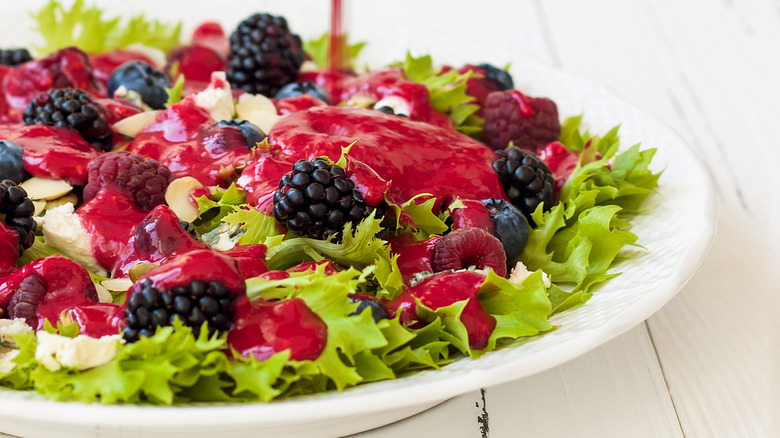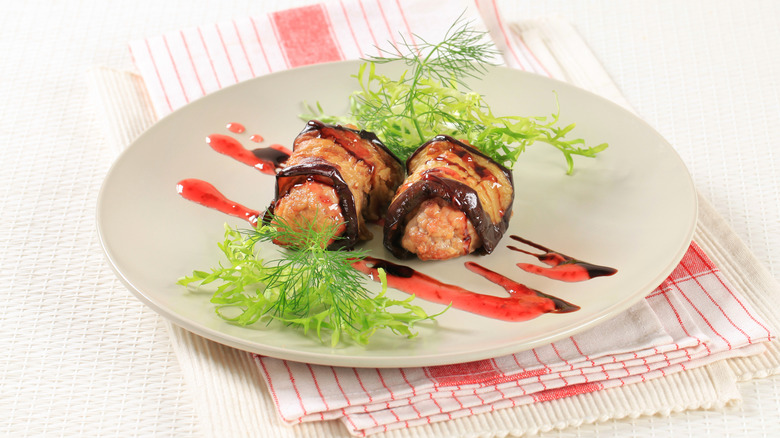The French Origins Of Raspberry Vinaigrette
Somehow, the seldom-celebrated raspberry vinaigrette has made itself a mainstay among the American salad dressing options found at almost any restaurant. No one bats an eye at its oddity or its place on salads. This is in part thanks to a few brands; sometime in the 1990s, Kraft and Newman's Own began mass-producing raspberry vinaigrette, making it a widely consumed dressing (via Taste). If you've ever tasted the dressing you likely have these companies to thank for its rise in mass popularity. If you've never had the pleasure of tasting raspberry vinaigrette, raspberry vinaigrette can best be described as a sweeter and lighter balsamic vinaigrette. The deep, sour notes of regular balsamic vinegar are replaced by the sweet tartness of raspberry reduction.
When you look up balsamic vinaigrette online, you'll find a plethora of recipes to make some at home, but if you search for raspberry vinaigrette, the top results will be bottled variations that you can purchase at supermarkets. Maybe people prefer to buy bottled raspberry vinaigrette because the addition of real fruit is hard to tackle at home. Either way, one of the most popular raspberry vinaigrette on the market, Newman's Own's, features black pepper, tons of corn syrup, anise, and elderberry juice. Although adding fruits and corn syrup to salad seems like a uniquely American practice, raspberry vinaigrette most likely came out of France.
Raspberry vinaigrette is born from France's nouvelle cuisine is
In the '70s, nouvelle cuisine took France by storm. Chefs were tired of haute cuisine, which emphasized fats, slow cooking, and elegance, per Britannica. With the spirit of modern-day minimalism and influences from Asia, French chefs decided to prioritize natural ingredients, lighter sauces, and creativity. Nouvelle cuisine devotees borrowed ingredients from different cultures and came up with inventive ways to serve French classics, like goose liver and salad, per The New York Times. Out of this moment came raspberry vinaigrette, a spin on traditional vinaigrette that infused real fruit into the dressing to add freshness to any plate. Although met with some criticism from French food conservatives, nouvelle cuisine was incredibly influential in both the '80s and '90s. Britannica notes that in 1997, around 70% of elite French chefs used nouvelle cuisine techniques in their signature dishes.
Once raspberry vinegar was brought to the United States, chefs at fine dining restaurants embraced it, drizzling it on salads, meats, and seafood. However, somewhere along the line, raspberry vinaigrette became a cliché for chefs who took themselves too seriously. By 1981, one of the founders of the nouvelle cuisine movement, French chef Michel Guerard, already felt that some of the cuisine's techniques were overplayed. He told The New York Times, "Where is the originality? ... Everything is cooked in either raspberry vinegar, strawberry vinegar, or pumpkin vinegar. It's sad."
Once Kraft's and Newman's Own had made their bottled versions, this delicate French dressing took on the image of a processed condiment rather than a fancy fruit-infused vinegar. Still, every time you reach for a bottle of raspberry vinaigrette, you can thank the inventiveness of French chefs decades ago.

